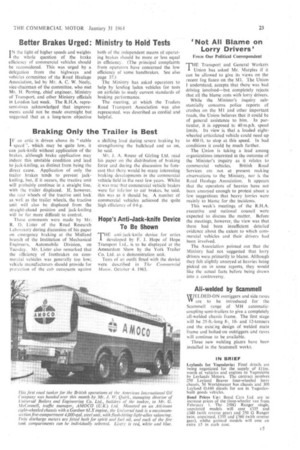Braking Only th e Trailer is Best
Page 25

If you've noticed an error in this article please click here to report it so we can fix it.
IIan artic is driven above its " stable I speed '', which may he quite low, it can jack-knife without application of the brakes, although brake application may induce this unstable condition and lead to jack-knifing, as distinct from being the direct cause. Application of only the trailer brakes tends to prevent jackknifing, but, if it occurs, the tractive unit will probably continue in a straight line, with the trailer displaced. If, however, the rear wheels of the tractive unit lock as well as the trailer wheels, the tractive unit will also be displaced from the straight-ahead position and jack-knifing will be far more difficult to control.
These comments were made by Mr: R. D. Lister of the Road Research Laboratory during discussion of his paper on emergency braking at the Midland branch of the Institution of Mechanical Engineers, Automobile Division, on Tuesday. Mr. Lister also remarked that the efficiency of footbrakes on cornmereial vehicles was generally too low; vehicle manufacturers should provide for pro,:ction of the cab occupants against
a shifting load during -severe braking by strengthening the bulkhead and so on, he said.
Mr, J. A. Rouse of Girling Ltd. read his paper on the distribution of braking force and during the discussion he forecast that there would be many interesting braking developments in the commercial vehicle field in the next few years. WhilSt it was true that commercial vehicle brakes were far inferior to cal' brakes, he said. this was as it should be. A number of commercial vehicles achieved the quite high efficiency of 0.6 g.




















































































































